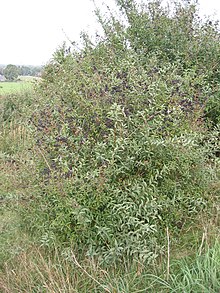| Privet | |
|---|---|

| |
| Ligustrum vulgare | |
| Scientific classification | |
| Kingdom: | Plantae |
| Clade: | Tracheophytes |
| Clade: | Angiosperms |
| Clade: | Eudicots |
| Clade: | Asterids |
| Order: | Lamiales |
| Family: | Oleaceae |
| Tribe: | Oleeae |
| Subtribe: | Ligustrinae |
| Genus: | Ligustrum L. |
| Species | |
|
See text | |

A privet is a flowering plant in the genus Ligustrum. The genus contains about 50 species of erect, deciduous or evergreen shrubs, sometimes forming small or medium-sized trees,[1] native to Europe, north Africa, Asia, many introduced and naturalised in Australasia, where only one species, Ligustrum australianum,[2] extends as a native into Queensland.[3] Some species have become widely naturalized or invasive where introduced. Privet was originally the name for the European semi-evergreen shrub Ligustrum vulgare, and later also for the more reliably evergreen Ligustrum ovalifolium and its hybrid Ligustrum × ibolium used extensively for privacy hedging, though now the name is applied to all members of the genus.[4] The generic name was applied by Pliny the Elder (23–79 AD) to L. vulgare.[5] It is often suggested that the name privet is related to private, but the OED states that there is no evidence to support this.[6]
- ^ Webb, C. J.; Sykes, W. R.; Garnock-Jones, P. J. 1988: Flora of New Zealand. Vol. IV. Naturalised Pteridophytes, Gymnosperms, Dicotyledons. 4. Christchurch, New Zealand, Botany Division, D.S.I.R.
- ^ Cite error: The named reference
RFKwas invoked but never defined (see the help page). - ^ RHS A-Z encyclopedia of garden plants. United Kingdom: Dorling Kindersley. 2008. p. 1136. ISBN 978-1405332965.
- ^ Casselman, Karen Leigh (11 August 1993). Craft of the Dyer: Colour from Plants and Lichens. ISBN 9780486276069.
- ^ Foster, Steven; Rebecca Johnson (2008). National Geographic Desk Reference to Nature's Medicine. National Geographic Books. p. 116. ISBN 978-1-4262-0293-3.
- ^ "privet". Oxford English Dictionary (Online ed.). Oxford University Press. (Subscription or participating institution membership required.)